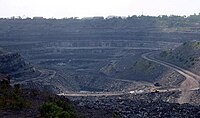
Photo from wikipedia
Coal is naturally enriched in trace elements, including mercury (Hg) and selenium (Se). Alkaline mine drainage from mountaintop mining valley fill (MTM-VF)—the dominant form of surface coal mining in Appalachia,… Click to show full abstract
Coal is naturally enriched in trace elements, including mercury (Hg) and selenium (Se). Alkaline mine drainage from mountaintop mining valley fill (MTM-VF)—the dominant form of surface coal mining in Appalachia, USA—releases large quantities of Se into streams draining mined catchments, resulting in elevated bioaccumulation of Se in aquatic and riparian organisms. Yet, the release of Hg into these streams from MTM-VF has not yet been studied. We measured total Hg, methylmercury (MeHg), and Se in stream water, sediment, biofilm, cranefly larvae, and riparian spiders in alkaline streams (pH range 6.9–8.4) across a mining gradient (0–98% watershed mined) in central Appalachia. Hg concentrations ranged from below detection limit (BDL)-6.9 ng/L in unfiltered water, BDL-0.05 µg/g in bulk sediment, 0.016–0.098 µg/g in biofilm, 0.038–0.11 µg/g in cranefly larvae, and 0.046–0.25 µg/g in riparian spiders. In contrast to Se, we found that Hg concentrations in all environmental compartments were not related to the proportion of the watershed mined, suggesting that Hg is not being released from, nor bioaccumulating within, MTM-VF watersheds. We also did not find clear evidence for a reduction in Hg methylation or bioaccumulation under elevated Se concentrations: water, sediment, biofilm, and riparian spiders exhibited no relationship between Hg and Se; only cranefly larvae exhibited a negative relationship (p = 0.0002, r2 = 0.42). We suggest that the type of surface mining matrix rock, with resultant alkaline or acid mine drainage, is important for the speciation, mobility, and bioaccumulation of trace elements within watersheds affected by mining activities.
Journal Title: Biogeochemistry
Year Published: 2020
Link to full text (if available)
Share on Social Media: Sign Up to like & get
recommendations!